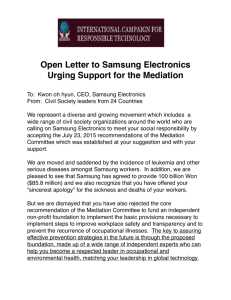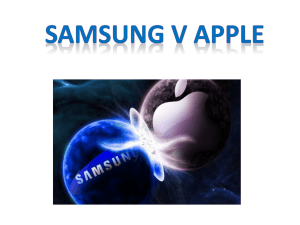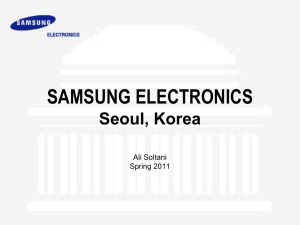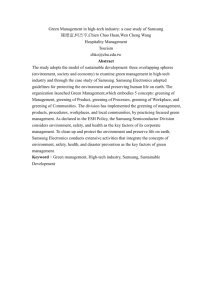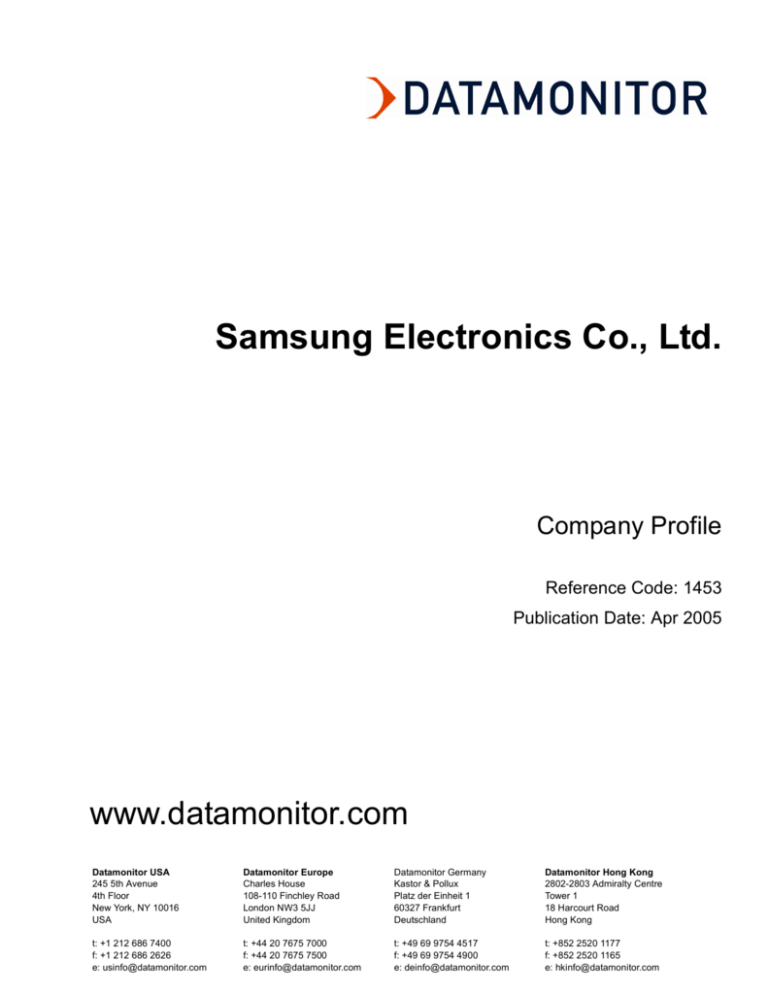
Samsung Electronics Co., Ltd.
Company Profile
Reference Code: 1453
Publication Date: Apr 2005
www.datamonitor.com
Datamonitor USA
245 5th Avenue
4th Floor
New York, NY 10016
USA
Datamonitor Europe
Charles House
108-110 Finchley Road
London NW3 5JJ
United Kingdom
Datamonitor Germany
Kastor & Pollux
Platz der Einheit 1
60327 Frankfurt
Deutschland
Datamonitor Hong Kong
2802-2803 Admiralty Centre
Tower 1
18 Harcourt Road
Hong Kong
t: +1 212 686 7400
f: +1 212 686 2626
e: usinfo@datamonitor.com
t: +44 20 7675 7000
f: +44 20 7675 7500
e: eurinfo@datamonitor.com
t: +49 69 9754 4517
f: +49 69 9754 4900
e: deinfo@datamonitor.com
t: +852 2520 1177
f: +852 2520 1165
e: hkinfo@datamonitor.com
ABOUT DATAMONITOR
Datamonitor is a leading business information company specializing in industry
analysis.
Through its proprietary databases and wealth of expertise, Datamonitor provides
clients with unbiased expert analysis and in depth forecasts for six industry sectors:
Healthcare, Technology, Automotive, Energy, Consumer Markets, and Financial
Services.
The company also advises clients on the impact that new technology and eCommerce
will have on their businesses. Datamonitor maintains its headquarters in London, and
regional offices in New York, Frankfurt, and Hong Kong. The company serves the
world's largest 5000 companies.
Datamonitor's premium reports are based on primary research with industry panels
and consumers. We gather information on market segmentation, market growth and
pricing, competitors and products. Our experts then interpret this data to produce
detailed forecasts and actionable recommendations, helping you create new business
opportunities and ideas.
Our series of company, industry and country profiles complements our premium
products, providing top-level information on 10,000 companies, 2,500 industries and
50 countries. While they do not contain the highly detailed breakdowns found in
premium reports, profiles give you the most important qualitative and quantitative
summary information you need - including predictions and forecasts.
All Rights Reserved.
No part of this publication may be reproduced, stored in a retrieval system or transmitted in any form by any
means, electronic, mechanical, photocopying, recording or otherwise, without the prior permission of the
publisher, Datamonitor plc.
The facts of this profile are believed to be correct at the time of publication but cannot be guaranteed.
Please note that the findings, conclusions and recommendations that Datamonitor delivers will be based on
information gathered in good faith from both primary and secondary sources, whose accuracy we are not
always in a position to guarantee. As such Datamonitor can accept no liability whatever for actions taken
based on any information that may subsequently prove to be incorrect.
Samsung Electronics Co., Ltd.
© Datamonitor
Page 2
SAMSUNG ELECTRONICS CO., LTD.
TABLE OF CONTENTS
TABLE OF CONTENTS
Company Overview ....................................................... 4
Key Facts........................................................................ 4
SWOT Analysis .............................................................. 5
Samsung Electronics Co., Ltd.
© Datamonitor
Page 3
SAMSUNG ELECTRONICS CO., LTD.
Company Overview
COMPANY OVERVIEW
Samsung Electronics (Samsung) provides electronic products including TVs,
computers and related products, semiconductors, and fiber optic products. The
company is part of the Samsung Group and operates in more than 30 countries. It is
headquartered in Seoul, South Korea and employs about 88,000 people.
The company recorded revenues of KRW57.6 trillion (approximately $56.9 billion)
during the fiscal year ended December 2004, an increase of 32.1% over 2003. The
operating profit of the company during fiscal 2004 was KRW12 trillion (approximately
$11.9 billion) compared to an operating profit of KRW7.2 trillion (approximately $7.1
billion) in fiscal 2003. The net profit was KRW10.8 trillion (approximately $10.7 billion)
during fiscal year 2004 compared to KRW6 trillion (approximately $5.9 billion) in 2003.
KEY FACTS
Head Office
Samsung Electronics Co., Ltd.
250, Taepyung-ro 2-ga
Jung-gu
Seoul 100 742
South Korea
Phone
+82 2 727 7114
Fax
+82 2 727 7985
Web Address
http://www.samsung.com
Revenues/turnover
56900
(US$ Mn)
Financial Year End
December
Employees
88000
SIC Codes
SIC 3631 Household Cooking Equipment
SIC 3632 Household Refrigerators and Home and Farm Freezers
SIC 3633 Household Laundry Equipment
SIC 3634 Electric Housewares and Fans
SIC 3635 Household Vacuum Cleaners
SIC 3639 Household Appliances, NEC
NAICS Codes
335221, 335222, 335224, 333414, 335211, 339999, 335212, 333298,
335212, 335228
Seoul Ticker
005930
Samsung Electronics Co., Ltd.
© Datamonitor
Page 4
SAMSUNG ELECTRONICS CO., LTD.
SWOT Analysis
SWOT ANALYSIS
Samsung develops and sells electronic products including TVs, computers and
related products, semiconductors, and fiber optic products. The company is part of the
Samsung Group. The company has a strong brand in the market and is present in
more than 30 countries in the world. However, the consolidation in the PC business
may put pressure on the price of computer related products like printers and monitors.
Strengths
Weaknesses
Market leading products
Product failure
Strong brand and global presence
Inconsistent sales growth
Strategic alliances
High dependence on the semiconductor business
Opportunities
Threats
Booming US semiconductor market
Shift from PC’s to MP3’s
Chinese market
Consolidation in the PC business
3G market
Slowing DRAM’s demand
Strengths
Market leading products
Samsung has a broad range of market leading products across the globe. It is the
market leader for TVs, Monitors, VCRs, LCD, Microwaves and CDMA Mobile phones.
The company became the second largest cell phone seller worldwide in December
2004, beating Motorola. Samsung holds the number one position in color monitor and
DRAM’s market. Holding a market leading position provides Samsung with
recognition which would aid the company in attracting customers.
Strong brand and global presence
Samsung enjoys high brand awareness and a reputation for innovation and quality. Its
strong brand creates barriers to entry in the markets it operates in and helps
guarantee future sales. Its global presence and operations in more than 30 countries
provides the company the benefits of diversification. .
Strategic alliances
Samsung Electronics Co., Ltd.
© Datamonitor
Page 5
SAMSUNG ELECTRONICS CO., LTD.
SWOT Analysis
Samsung has been involved in many successful strategic alliances. The company has
formed strategic partnerships with a number of well known companies including
Maytag (for washing machines); IBM (for technology development); Sony (an
exclusive patent cross-licensing agreement to share knowledge on developing
technologies); Time Warner Cable (for building two-way interactive-compliant TV sets
and cable infrastructure); and IMEC (to develop key technologies for future portable
communication products). Samsung has also established a Samsung-Toshiba joint
venture for optical storage devices. Working in close relationships with companies
such as Microsoft, Sony, and AOL provides Samsung with valuable technical
knowledge.
Weaknesses
Product failure
The company’s sliding phones have not been well accepted in Europe. Samsung’s
sliding phones saw disappointing sales in Europe, especially the newly released
E800. Component makers have noted that orders for components of sliding phones
have been short of forecast by about 30%. Samsung is pushing the sale of sliding
phone as another form factor to differentiate the company’s brand. The company may
not be in a position to recover it expenses including the research and development
expenses that it incurred for manufacturing the phones.
Inconsistent sales growth
The company’s sales growth has been uneven since 2000. Samsung’s sales grew by
31.3% in 2000, (5.6%) in 2001, 25.1% in 2002, 7.6% in 2003 and by 32.2% in 2004.
Growth has not followed any consistent path, and the historical sales growth trend is
indicative of its inability to align business and operating strategy with market
conditions.
High dependence on the semiconductor business
During fiscal 2004, the company generated an operating profit of KRW12 trillion
(approximately $11.7 billion). The semiconductor division contributed 62.2% of the
total
operating
profit
(KRW7.5
trillion
or
$7.3
billion)
during
2004.
The
telecommunication networks division (operating profit of KRW2.8 trillion or $2.7 billion)
and the LCD division (KRW1.9 trillion or $1.9 billion) accounted for 39.2% of the total
operating profit. Other divisions including digital media and digital appliance incurred
operating. The company is highly dependent on the semiconductor business to
generate cash flows. The business contributes disproportionately to operating profit
Samsung Electronics Co., Ltd.
© Datamonitor
Page 6
SAMSUNG ELECTRONICS CO., LTD.
SWOT Analysis
as it accounts for about 31.6% of total revenues. With an increasing Won and rising
price commoditization in the semiconductor business, Samsung would find it
challenging to maintain existing profitability levels in this segment.
Opportunities
Booming US semiconductor market
In 2004, the US semiconductor industry posted higher growth rates, compared to
2003, driven primarily by wireless communication chips. The industry size was
estimated at $69.3 billion in 2003, with annual growth in demand forecasted at 14.1%
till 2008. Demand from the processor-based electronic goods industry is expected to
propel most of the growth in the future. Samsung’s major presence in the US and the
booming US semiconductor market may fuel demand for the company’s
semiconductor products.
Chinese market
Leading technology companies are shifting their production base to Asia, particularly
China and Southeast Asia, to take advantage of lower production costs. China
represents a highly lucrative and attractive market for Samsung. It can provide good
growth prospects in its emerging and growing markets. The Chinese and Asia-Pacific
market for mobile phone handsets is estimated to be the only major world market to
demonstrate double-digit growth in 2005. In February 2004 Samsung increased its
presence in China establishing a SystemLSI research facility in Hangzhou. Also In
April 2004 the company revealed it had entered into a joint venture agreement with
Eastern Communications in east China. The growing Chinese market offers
numerous opportunities for the company as a market and as a low cost production
base.
3G market
During February 2005, Samsung launched a new range of 3G handsets, including the
SGH-Z500, which it claims is the world’s smallest 3G handset. The company unveiled
the SGH-Z300 and SGH-Z130, as well as the SGH-Z500 handsets. It is expected that
in 2005, 3G technology will become increasingly popular and that its new range of
handsets will meet the demands of a more intuitive consumer. These new 3G
products may help the company in winning market share of the booming 3G market.
Threats
Shift from PC’s to MP3’s
Samsung Electronics Co., Ltd.
© Datamonitor
Page 7
SAMSUNG ELECTRONICS CO., LTD.
SWOT Analysis
Samsung is targeting digital consumer products and semiconductors. To do so, the
company requires better brand recognition as well as development capability to
differentiate itself from the competition in increasing memory density. This is
especially true as demand is gradually shifting from performance-driven products,
such as PCs, to entertainment-driven products, such as MP3. The company’s
relatively lower exposure to this market as compared to peers such as Matsushita
would weaken its position in the market.
Consolidation in the PC business
The PC business, the largest customer segment of the computer storage devices
industry, is consolidating. Mergers and acquisitions in the PC business (including the
HP-Compaq merger and the IBM-Lenovo deal) have resulted in the formation of large
clients, with higher bargaining power. This is expected to further reduce margins of
computer products including monitors, LCD panels and printers, thus affecting the
company’s margins.
Slowing demand for DRAM
The demand of DRAM (dynamic random access memory) is related to the demand for
PC’s. In 2005, it is expected that annual PC unit shipments will grow by 8%, which is
lower than the 11% growth in both 2003 and 2004. Due to a slowdown in the PC
market, the demand for Samsung’s products including DRAM would also slow.
Furthermore, as the next replacement cycle is not expected before 2007, the growth
for DRAM would be slow in the short term.
Samsung Electronics Co., Ltd.
© Datamonitor
Page 8


